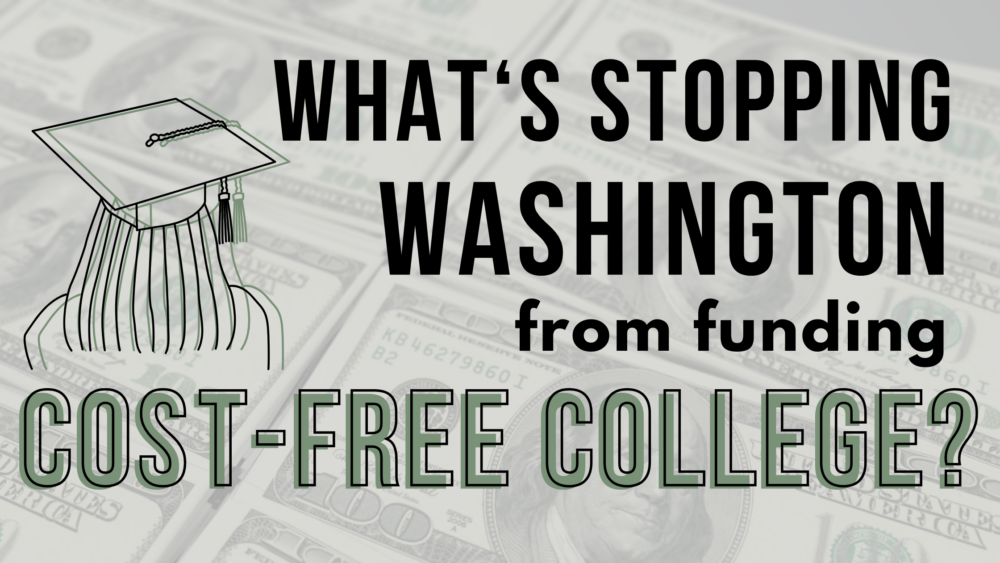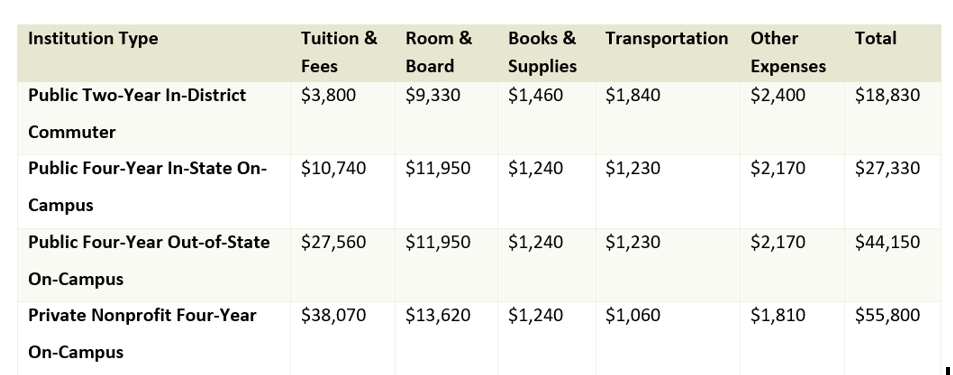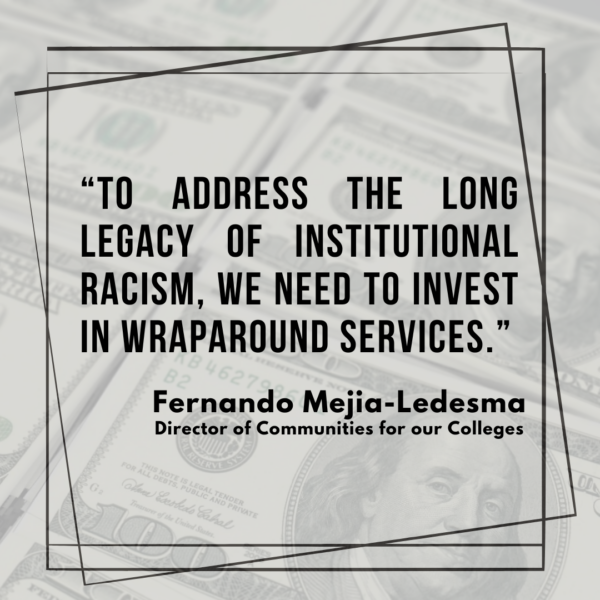
If the world of higher education feels complicated and vast, that’s because it is. Trade school, grad school, masters degrees, Running Start, four-year, two-year, land-grant colleges, private, public, for-profit, online, hybrid; expanding cultural horizons, learning basic skills, pursuing advanced degrees, training in technical fields – “higher ed” includes many kinds of schooling.
And paying for it is just as confusing. Pell grants, Washington College Grant, Promise programs, loan-forgiveness, FAFSA – we know that student debt is a massive issue, but the intricacies aren’t so easy to understand.
Maybe, then, the reason that some reject the idea of cost-free college is because it just sounds too simple.
What does cost-free college have to do with taxes?
We have weighed in on the higher education conversation in the past to highlight the need for greater state funding of our public institutions. Washington has one of the most regressive (second only to Florida now) tax codes in the nation.
The way we collect revenue is unfair for working people, out-of-date, and inadequate. And this broken system doesn’t just impact graduates. Passing progressive revenue policies could provide ongoing funding sources for public higher education.
This greater state funding could not only be used to lessen the student share of higher education, which has crept up significantly over the years, but go farther, to cost-free college.
A bit of history reveals how we got to where we are today.
The 1980s began a decades-long (and ongoing) privatization of the public sphere, with the growing influence of the conservative ideology of Margaret Thatcher and Reaganomics. At the same time, who got to go to college started shifting dramatically after the civil rights movement of the 1960s
How the dream of “working your way through college” died
As college student bodies became more diverse, austerity increased. State funding of public institutions was ratcheted back and the student share of costs increased. As we reported in 2019:
In 1980, a student could earn enough working just one summer (seven weeks) at minimum wage to cover tuition at any of the state’s 4-year colleges or universities — and just three weeks to pay for community or technical college — because state funding for higher education kept costs affordable.
Today, it would take six months of full-time work at minimum wage to pay for the University of Washington or Washington State University. The Evergreen State College, Eastern, Central or Western Washington University would require four months. And for those looking to attend a community or technical college, it would require two months.
While the student share of higher education has increased, the cost of living has also increased dramatically. Unsurprisingly, student debt has been increasing together with these cost trends.
Nearly one-third of students who’ve borrowed money to attend college have debt but no degree. One major driver of this trend is the total cost of attending college has increased so much. Housing and food are equally expensive across institution types:

Adapted from College Board 2021 Trends in College Pricing Research
Thus, when we think about the cost of education, we must reject outdated notions of what college should cost, how students should pay for school, and instead, try to better understand the realities of what they face. That means we must consider costs beyond tuition and fees. We must consider the true cost of being a student, at this time in history. That includes transportation, books and supplies, housing, and food.
As politicians bicker, students are advocating for themselves
A large number of students, staff, and faculty have been organizing around policies that would move Washington toward a more equitable higher education system. Communities for our Colleges (C4C), a campaign of the Alliance for a Just Society, is led by student organizers from community and technical colleges (CTCs) across the state. Their work includes taking stock of Washington students’ realities, organizing with those students, and leading with a vision that will make their lives better.
The inclusion of students from CTCs within the cost-free college conversation is critical. Compared to four-year schools, the makeup of Washington’s CTCs is diverse. Just over half of the student body identifies as people of color. The coalition reflects the students’ racial diversity, as well as the predominance of first-generation students, immigrants, and undocumented students within the CTC system.
“For many students, access to four-year colleges is not an option,” says Fernando Mejia-Ledesma, C4C’s Director. “The first option they have is to attend their local community college. The majority of our CTC students are students of color and have low wealth.”
From his own lived experience, as well as his work with the coalition, Mejia-Ledesma has seen the ways that more public revenue for higher education would impact students. This is especially true for those who are first-generation, BIPOC, immigrant, and undocumented.
Cost-free college is about more than tuition
We’ve all felt the impact of corporate greed masked as inflation – and would-be college students are no exception. In fact, these same CTC students are most impacted by rising costs, from housing to food, to supplies. Students from marginalized communities may be able to cover tuition, but the additional costs make college unavailable.
“Attending their local CTC is the first step to transforming their lives, but the CTC system has been historically underfunded,” explains Mejia-Ledesma. “If we are true to our equity values, we would support students with tuition expenses and wraparound supports such as access to healthy food, reliable transportation, and housing. To address the long legacy of institutional racism, we need to invest in wraparound services.”
“While I dreamed of attending prestigious culinary institutions, the costs were just too high,” says culinary student Rosalina Anderson, who shared her story with C4C. “Even community college is tough for me to afford, even working 80 hours a week during summer and 40 hours a week on top of school. I do it because I have a passion for what I do and a passion for learning. The financial challenges I face are enormous. My materials are not affordable at all.”

Legislative vision – without revenue to make it reality
A number of bills in recent years have addressed components of this vision. Unfortunately, the legislature hasn’t taken the bold move of fully funding it.
Several bills aimed at making college more affordable were unable to clear their house of origin. HB 2309, for example would have provided eligible students up to 45 tuition-free community or technical college credits.
Another, HB 2374, would provide students with even more even more – up to 90 tuition-free community or technical college credits. It would also include “student success and advising courses, a basic attendance grant, wraparound services, and notifications to high school juniors and seniors,” according to the Washington State Board of Community and Technical Colleges.
Two bills – SB 5904, which expands the length of the Washington College grant and College Bound scholarship, and HB 1889, a priority of the Communities for our Colleges coalition, which provides pathways to professional licensure for immigrants and undocumented people – did pass.
This short-sightedness goes hand-in-hand with our out-of-date tax code.
The idea that we don’t have the money to provide cost-free college in Washington is simply untrue.
We have the resources to help students like Rosalina achieve their dreams, meet their goals, and become productive members of our community. There’s plenty of (extreme) wealth in Washington.
We need to look no further than the recently-passed capital gains tax to see that this is true. Just a tiny fraction of our state’s residents hold enormous amounts of money – and they can and must pay taxes on that wealth. Washington has the ability to raise substantial sums of money without further taxing the non-wealthy. Our lawmakers just need to make that decision.
To be clear, some Washington lawmakers are pushing to make these changes. Since 2016, there have been proposals for cost-free college and reduced tuition in nearly every legislative session. In the 2024 legislative session, Rep. Gerry Pollet, D-Seattle, and Rep. Steve Bergquist, D-Renton both introduced bills specifically designed to help close equity gaps and reduce the cost of community college. In one piece of testimony, Berquist noted that our current structure has created “a canyon of affordability.”
Unfortunately, none of these policy proposals have included a truly cost-free college with wraparound services, fully funded with public dollars from progressive taxes.
We have the money for cost-free college. We just need to collect it.
Many proposals to bring down the cost of college have come from Olympia over the last decade. Without a significant, sustainable investment, though, any new legislation around college affordability will fall short of the needs of students. Passing a state wealth tax could raise billions of new dollars a year, every year, without burdening those who are already shouldering the burden. The Department of Revenue estimates that a 1% tax on financial wealth in excess of $250 million would raise around $3 billion a year. Only about 700 individuals across the state would pay this tax.
Compare that to the cost of fully funding the vision for cost-free community and technical college, including comprehensive wrap-around services. Even with money for books, supplies, and housing, cost-free college would cost a fraction of the money raised from taxing Wall Street wealth.
Though the numbers are still somewhat rough, estimates for providing for cost-free community and technical college have ranged between $100 to $150 million a year. This is just a fraction of the revenue raised each year by the capital gains tax, which raised around $800 million in public revenue in its first year. It’s an even smaller fraction of the revenue anticipated to be raised by a state wealth tax.
Importantly, that money would go straight back into the community. Helping students afford rent, supplies, food, and other needs is beneficial to the local community and to students.
“In general, if people had access to education, it would change so much because people would follow their dreams,” stated another C4C member. “Not to be dramatic, but free college would change the world.”
It’s not dramatic. Cost-free college is a transformative idea. Next session, we’ll be looking at lawmakers to pass this vision into reality.
Find C4C on social media:
Twitter | Facebook | Instagram
More To Read
March 24, 2025
Remembering former Washington State House Speaker Frank Chopp
Rep. Chopp was Washington state’s longest-serving Speaker of the House
February 11, 2025
The rising cost of health care is unsustainable and out of control
We have solutions that put people over profits
January 29, 2025
Who is left out of the Paid Family and Medical Leave Act?
Strengthening job protections gives all workers time they need to care for themselves and their families
